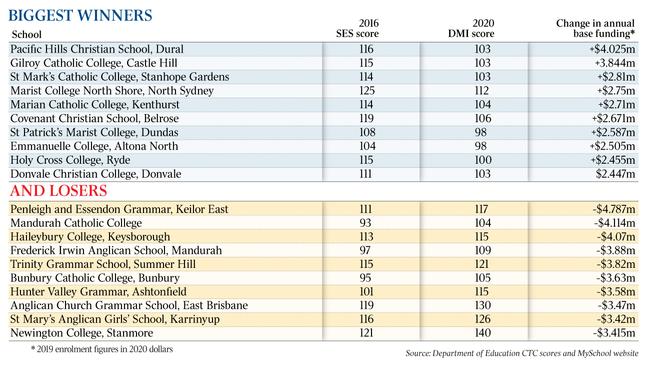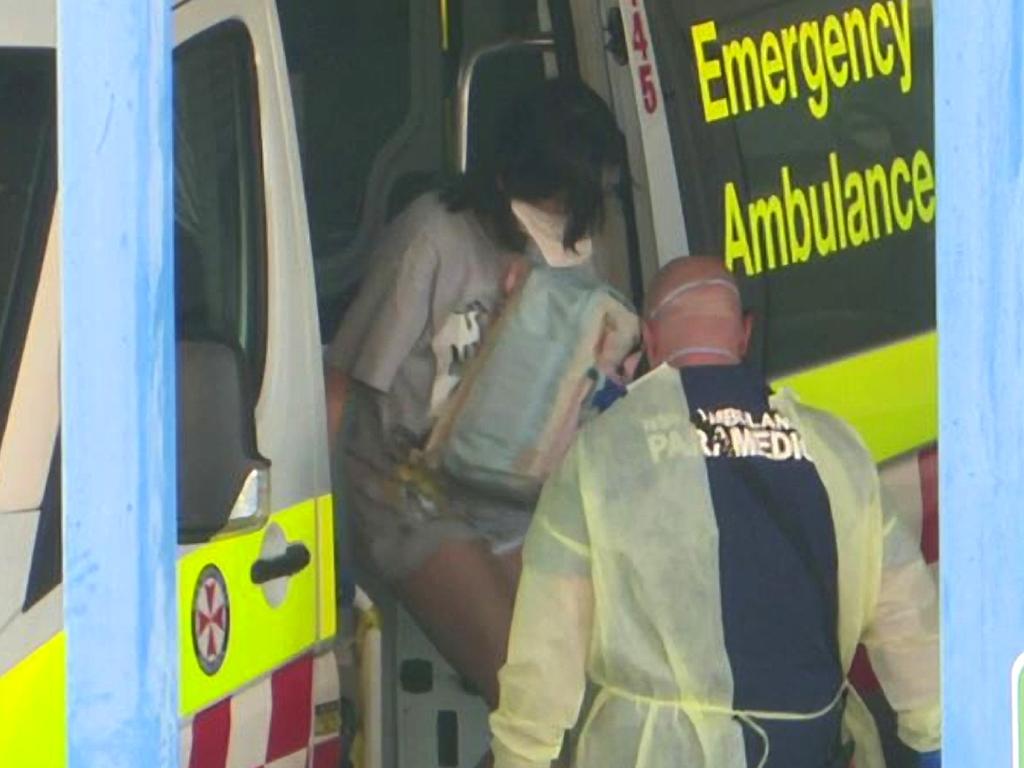Elite schools face fee hikes under means-tested funding
Fees at some top private schools are poised to rise under a new funding model taking into account students’ family incomes.

Fees at some of the nation’s top private schools are poised to rise under a new funding model that takes into account students’ family incomes, as significant taxpayer funds are redistributed to faith-based schools.
More than 160 non-government schools each stand to lose more than $1m of their annual base funding entitlements under the system, while about 100 schools are set to receive seven-figure windfalls. Catholic and Christian schools have emerged as the biggest beneficiaries of the federal government’s decision to introduce means testing, via a direct measure of family income, to determine non-government school funding.
The latest Capacity to Contribute (CTC) scores, published by the Department of Education last week, reveal that, for many schools, new direct measure of income (DMI) scores — based on the median family income of the school community — vary significantly from previously employed SES scores.
The differences equate to multi-million-dollar changes to schools’ base funding entitlements from this year.

Pacific Hills Christian School in Dural in Sydney’s northwest, could attract an additional $4m in annual recurrent funding, based on its most recently published student enrolment figures. Gilroy Catholic College in Castle Hill could receive an extra $3.8m, while St Mark’s Catholic College and Marist College North Shore, both in Sydney, stand to gain about $2.8m respectively.
At the other end of the spectrum, Melbourne independent school Penleigh and Essendon Grammar School could forgo almost $4.8m in annual base funding, Mandurah Catholic College in Western Australia could lose $4.1m.
Trinity Grammar School and Newington College in Sydney, as well as Anglican Church Grammar in Brisbane, each face losing more than $3m a year. The funding methodology changes, which stem from the 2018 Chaney Review, have been broadly welcomed by the Catholic education sector, which had long argued that the previous system disadvantaged its schools, particularly low-fee, parish schools.
FULL LIST: To read the full list, click here
However, the independent sector has warned that the new system is too narrow when it comes to determining a school community’s capacity to contribute and that regional schools would be hardest hit. It has also warned that some schools would have no option other than to increase fees.
Federal Education Minister Dan Tehan defended the new funding model on Sunday, arguing that the government was investing an additional $3.4bn in non-government schools as they transitioned to the new arrangements from 2020 to 2029.
“Under previous arrangements, capacity to contribute was calculated using the SES score derived from the average characteristics of all households in the area where the students lived, irrespective of whether the households had students who went to the school,” Mr Tehan said.
“Recent innovations mean that a more direct measure of a school community’s capacity to contribute is now available. This more accurate approach will ensure more funding flows to the schools that need it the most.”
In a submission to a recent Senate inquiry into the new Direct Measure of Income Bill, the Coalition of Regional Independent Schools Australia highlighted the case of Hunter Valley Grammar, which has 1070 students, and was set to have federal funding drop by 21 per cent as a result of its higher direct measure of income score.
“To offset such losses, fee increases from 2022 to 2029 will need to be at least 6 per cent annually,” the coalition said.
“The Year 12 fee is currently $18,600. By 2030, the school will need to charge $32,000 per annum.”
The Anglican Schools Corporation, whose 27 NSW schools include Claremont College, Roseville College and Penrith Anglican College, has estimated a combined $59m funding hit between 2022 and 2029.

It said the new model had created “significant” financial concerns and would negatively impact on its capacity to “expand our offering of affordable, quality education to families across a range of socio-economic backgrounds”.
Association of Independent Schools of NSW chief executive Geoff Newcombe has described the use of median income alone to calculate Capacity to Contribute scores as “problematic” as it presumed all families in a particular school were on similar incomes.
That was often not the case in rural and regional areas, Dr Newcombe said in his submission to the Senate inquiry.
“Many independent regional and boarding schools will be unfairly impacted by the large and unexpected increase in their CTC scores — in some cases, by more than 10 points,” he said. “Of the 40 NSW independent boarding schools, 32 have had their CTC scores increased (and) of these, 22 will have their funding reduced.”
In a submission to the same inquiry, St Paul’s Grammar principal Ian Wake said the Penrith school was set to lose almost $1.5m in annual base funding as a result of its score rising from 102 to 110.
“If the school has a funding reduction then we would be forced to increase fees, which would mean that many families who already make significant sacrifices and stretch themselves financially to attend the school would be unable to continue their enrolment,” he said, adding that the school already offered a relatively high level of fee assistance to families.
Under federal funding arrangements for the non-government sector, schools’ recurrent funding is based on enrolment numbers and is discounted according to their capacity-to-contribute score.
Schools with a score of 93 or less are entitled to 90 per cent of their base funding — set in 2020 at $11,474 per primary student and $14,761 for secondary students — while for a school with a score of 125 or higher the funding entitlement is reduced to 20 per cent.
That also means that some of the wealthiest schools across the nation — those with capacity-to-contribute scores above 125 — will be unaffected by the changes. For example, Ascham School in the Sydney suburb of Edgecliff has a direct measure of income score of 154 compared to its previous SES score of 126. As it was already receiving the maximum funding discount, its 2020 base funding entitlement remains unchanged. The same applies for many high-fee independent Sydney schools, such as SCEGGS Darlinghurst, Cranbrook and Sydney Grammar.
To lessen the impact on some schools, the schools that will receive less under the new regime will be able to rely on the old model to determine funding until 2022, after which funding reductions will be phased in until 2029.
Schools entitled to more under the new system can access increased funding from this year.







To join the conversation, please log in. Don't have an account? Register
Join the conversation, you are commenting as Logout